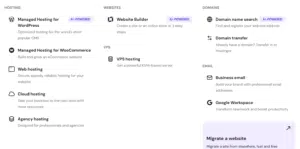Hostinger is better for most business websites due to its superior performance, more extensive feature set, and better value despite slightly higher pricing. Hostinger delivers significantly faster loading times (3x faster than DreamHost in tests), offers more robust server infrastructure with LiteSpeed technology, provides more global data centers, and includes essential business features like free email accounts and domain privacy that DreamHost charges extra for.
The Core Difference for Business Websites
Hostinger delivers exceptional speed that directly impacts your business success. Your website loads in under 1 second (769ms in tests, with optimized sites as fast as 482ms), keeping visitors engaged and improving conversion rates.

DreamHost provides reliable service with impressive uptime guarantees. Their 100% uptime promise (versus Hostinger’s 99.9%) translates to consistent availability for your business website.
The performance gap becomes critical during traffic surges. Hostinger handled 1000 virtual visitors with minimal slowdown (47ms average response time), while DreamHost failed with a 51.4% error rate and extreme slowdowns (7230ms average response).
Business owners face a fundamental choice between speed and initial cost savings. Hostinger sacrifices some initial affordability for significantly better performance, while DreamHost offers lower entry pricing at the cost of speed.
Performance: The Business Impact
Hostinger excels with its LiteSpeed web server technology that powers business websites efficiently. This advanced server software handles high-traffic situations without breaking down, maintaining performance during peak business hours.
DreamHost utilizes Apache and Nginx server technologies that provide adequate performance for lower-traffic sites. These traditional server options struggle under heavy loads, potentially causing lost sales during traffic spikes.

The speed difference creates tangible business results. Hostinger’s faster loading times (769ms versus DreamHost’s 2.6 seconds in some tests) directly improve conversion rates, with research showing even 1-second delays can reduce conversions by 7%.
Website reliability impacts your business reputation significantly. Both hosts maintain excellent uptime, with Hostinger achieving 99.997% (including five consecutive months at 100%) and DreamHost reaching 99.96% (with four consecutive months at 100%).
The performance gap widens dramatically during traffic surges. Hostinger maintained 301ms response times even under heavy load, while DreamHost experienced catastrophic slowdowns exceeding 10 seconds with most visitors unable to access the site.
Global Reach and Infrastructure
Hostinger operates an extensive global network with data centers across multiple continents. Your business website loads quickly for visitors worldwide, improving international sales potential.

DreamHost maintains a more limited infrastructure primarily focused on US locations. This concentration benefits US-based businesses but creates potential slowdowns for international visitors.
The geographic advantage translates to measurable performance differences. Hostinger delivers consistent sub-second loading times globally, while DreamHost shows significant performance degradation for visitors outside North America.
Business expansion requires infrastructure that grows with you. Hostinger’s global presence supports international business growth more effectively than DreamHost’s US-centric approach.
The technology stack creates fundamental performance differences. Hostinger’s LiteSpeed servers with NVMe SSD storage provide enterprise-grade performance at mid-range pricing, while DreamHost’s more traditional infrastructure delivers adequate but not exceptional performance.
Pricing and Value for Businesses
Hostinger structures its pricing to deliver maximum value for growing businesses. The Premium plan ($2.99/month) supports 100 websites with 100GB storage, providing room for business expansion.

DreamHost offers slightly lower entry pricing but with significant limitations. Their Shared Starter plan ($2.59/month) supports only one website with 50GB storage, restricting business growth.

The total cost calculation reveals important differences. Hostinger includes essential business features like email accounts and domain privacy in their base pricing, while DreamHost charges additional fees ($1.67/month for email).
Long-term value favors Hostinger despite higher initial costs. The performance advantages, included features, and scalability provide better return on investment for business websites focused on growth.
The renewal pricing gap narrows significantly. DreamHost’s plans increase substantially after the first year ($6.99/month), while Hostinger maintains more reasonable renewal rates relative to the features provided.
| Feature | Hostinger | DreamHost |
|---|---|---|
| Starting Price | $2.99/month (Premium) | $2.59/month (Shared Starter) |
| Renewal Price | Higher than intro | $6.99/month |
| Websites Allowed | 100 | 1 (Unlimited on higher plan) |
| Storage | 100GB SSD | 50GB SSD |
| Bandwidth | Unlimited | Unmetered |
| Server Technology | LiteSpeed | Apache/Nginx |
| Performance | Excellent (769ms load time) | Good (2.6s load time) |
| Uptime | 99.997% | 99.96% |
| Traffic Handling | Excellent (47ms avg response) | Poor (7230ms avg response) |
| Global Data Centers | Multiple (US, Europe, Asia, S. America) | Limited (US only) |
| Free Domain | Yes (1st year) | Yes (1st year) |
| Domain Privacy | Free | Free |
| Email Accounts | Free (up to 100) | Paid add-on ($1.67/month) |
| SSL Certificate | Free | Free |
| Backups | Weekly (Daily on higher plans) | Daily automated |
| WordPress Features | Managed features included | Basic and managed plans |
| Website Builder | AI-powered builder included | Builder included |
| Customer Support | 24/7 live chat | 24/7 support (limited live chat) |
| Money-back Guarantee | 30 days | 97 days |
| WordPress Recommendation | No | Yes (WordPress.org recommended) |
| Best For | Performance-focused business sites | Budget-conscious simple sites |
| Load Test Results | Passed 1000 visitors test | Failed with 51.4% error rate |
| GTmetrix Grade | A | B |
| TTFB | 314ms | 199ms |
| Full Load Time | 769ms | 482ms-2.6s (inconsistent) |
Features That Impact Business Success
Hostinger provides comprehensive business-focused features that drive growth. The platform includes managed WordPress capabilities, AI website builder, and advanced security features in all plans.
DreamHost offers solid fundamentals but charges extra for business essentials. Their base plan lacks email hosting ($1.67/month additional), limiting its value for professional websites.
The website building experience differs significantly. Hostinger’s AI website builder creates professional business sites quickly, while DreamHost’s builder offers adequate but less advanced functionality.
Business security receives different emphasis across platforms. Both provide essential SSL certificates, but Hostinger adds WordPress vulnerability scanning and advanced security features that benefit business reputation.
The scalability options favor different business trajectories. Hostinger excels for growing businesses with its 100-website allowance even on mid-tier plans, while DreamHost’s single-website limitation on the starter plan restricts expansion.
| Business Feature | Hostinger | DreamHost |
|---|---|---|
| Email Hosting | Included (up to 100 accounts) | $1.67/month add-on |
| Website Limit | 100 sites | 1 site (base plan) |
| Storage | 100GB SSD | 50GB SSD |
| WordPress Tools | Extensive (staging, scanner) | Basic (more in managed plans) |
| Security Features | Comprehensive suite | Standard protection |
WordPress Optimization
Hostinger delivers comprehensive WordPress optimization out of the box. The platform includes LiteSpeed Cache, WordPress acceleration, vulnerability scanning, and staging environments even in mid-tier plans.

DreamHost offers basic WordPress support with specialized managed plans available. Their WordPress.org recommendation provides credibility, though their standard plans include fewer WordPress-specific features than Hostinger.
The performance difference impacts WordPress sites significantly. Hostinger’s LiteSpeed infrastructure creates faster-loading WordPress sites (A grade in GTmetrix versus DreamHost’s B grade).
WordPress security receives different treatment across platforms. Hostinger includes WordPress vulnerability scanning and automatic updates, while DreamHost provides solid fundamentals but fewer specialized WordPress security features.
The development workflow varies between providers. Hostinger includes staging environments and developer tools in standard plans, while DreamHost reserves some advanced WordPress features for their higher-tier managed plans.
| WordPress Feature | Hostinger | DreamHost |
|---|---|---|
| WordPress Installation | One-click | One-click |
| Managed Features | Included in standard plans | Separate managed plans |
| Performance Optimization | LiteSpeed Cache, acceleration | Standard optimization |
| Staging Environment | Yes | On managed plans |
| WordPress.org Recommendation | No | Yes |
Customer Support Experience
Hostinger provides comprehensive 24/7 support through multiple channels. Their live chat response times average under 5 minutes, with knowledgeable agents available around the clock.
DreamHost offers 24/7 support with some limitations on live channels. Their ticket system provides reliable assistance, though live chat availability is more restricted than Hostinger’s always-available option.
The knowledge base quality differs between providers. Both offer extensive documentation, though Hostinger’s resources receive more frequent updates and cover a broader range of topics.
Support responsiveness creates different business experiences. Hostinger’s more immediate support helps resolve business-critical issues faster, minimizing potential downtime or problems.
The support channels cater to different communication preferences. Hostinger emphasizes live chat for immediate assistance, while DreamHost focuses more on their ticket system and knowledge base.
| Support Feature | Hostinger | DreamHost |
|---|---|---|
| Live Chat | 24/7 | Limited hours |
| Ticket System | 24/7 | 24/7 |
| Knowledge Base | Extensive | Comprehensive |
| Response Time | Very fast | Good |
| WordPress Expertise | High | High |
Scalability and Business Growth
Hostinger accommodates business growth with flexible scaling options. The platform allows 100 websites even on mid-tier plans, with easy upgrades to cloud hosting for growing traffic.
DreamHost restricts initial growth with single-website limitations. Their upgrade path exists but requires plan changes earlier in the business growth cycle.
The resource allocation supports different business trajectories. Hostinger provides more storage (100GB vs 50GB) and better performance optimization for growing traffic.
Traffic handling capabilities create different growth ceilings. Hostinger successfully managed 1000 simultaneous visitors in testing, while DreamHost struggled significantly with the same load.
The hosting types available cover different business needs. Both providers offer shared, WordPress, VPS, and cloud options, though Hostinger adds specialized hosting types like Minecraft server hosting.
Security and Reliability for Business
Hostinger implements comprehensive security measures that protect business reputation. The platform includes malware scanning, WordPress vulnerability detection, and advanced DDoS protection.
DreamHost provides solid security fundamentals with some advanced features. Their security approach focuses on reliable basics rather than the more comprehensive suite offered by Hostinger.

The backup systems follow different philosophies. DreamHost includes daily automated backups in all plans, while Hostinger provides weekly backups (daily on higher plans).
Business continuity planning differs between providers. DreamHost’s longer money-back guarantee (97 days versus Hostinger’s 30 days) provides more time to evaluate the service.
The uptime guarantees reflect different reliability approaches. DreamHost’s 100% uptime guarantee exceeds Hostinger’s 99.9% promise, though actual performance shows both maintain excellent availability.
| Security Feature | Hostinger | DreamHost |
|---|---|---|
| SSL Certificates | Free unlimited | Free |
| Malware Protection | Included | Basic |
| DDoS Protection | Advanced | Standard |
| Backup Frequency | Weekly (Daily on higher plans) | Daily automated |
| WordPress Security | Vulnerability scanning | Standard protection |
My Recommendation for Businesses
Most businesses should choose Hostinger in 2025. The platform delivers superior performance, more comprehensive features, and better value despite slightly higher initial pricing.
Specific businesses might prefer DreamHost despite its limitations. Those with extremely tight initial budgets, simple single-site needs, or US-only audiences may find DreamHost’s lower entry price attractive.
The performance difference creates the most compelling business case for Hostinger. Their significantly faster loading times and superior traffic handling directly impact customer experience and conversion rates.
The feature comparison reveals Hostinger’s business advantage. Included email hosting, domain privacy, and advanced security features provide better value than DreamHost’s lower base price with add-on costs.
The platform that delivers the best customer experience ultimately generates the most business value. Hostinger’s speed advantage (3x faster in some tests) creates tangible benefits that outweigh the slightly higher initial investment.
Frequently Asked Questions
Q: Which hosting provider offers better performance for business websites?
A: Hostinger delivers significantly better performance for business websites. Tests show Hostinger loads websites up to 3 times faster than DreamHost (769ms vs 2.6s in some tests), and Hostinger successfully handled 1000 simultaneous visitors while DreamHost failed with a 51.4% error rate. Hostinger’s LiteSpeed web server technology provides superior performance under load compared to DreamHost’s Apache/Nginx setup, making it the better choice for business sites expecting traffic growth or spikes.
Q: Is DreamHost or Hostinger more affordable for small businesses?
A: DreamHost offers slightly lower entry pricing ($2.59/month vs Hostinger’s $2.99/month), but Hostinger provides better overall value for businesses. DreamHost charges extra for essential business features like email hosting ($1.67/month additional) and limits you to a single website on their starter plan. Hostinger includes 100 websites, 100GB storage (vs DreamHost’s 50GB), and free email accounts in their base plan. When considering total cost including necessary business features, Hostinger often works out more economical despite the slightly higher base price.
Q: Which hosting provider offers better WordPress features?
A: Hostinger provides more comprehensive WordPress features in their standard plans. While DreamHost is officially recommended by WordPress.org, Hostinger includes managed WordPress features like LiteSpeed Cache, vulnerability scanning, staging environments, and performance optimization in all plans. DreamHost offers basic WordPress support in standard plans with more advanced features reserved for their separate managed WordPress plans. For businesses needing WordPress-specific features without paying for managed plans, Hostinger offers better value.
Q: How do uptime guarantees compare between Hostinger and DreamHost?
A: DreamHost offers a stronger uptime guarantee at 100% compared to Hostinger’s 99.9% promise. However, real-world testing shows both providers deliver excellent reliability, with Hostinger achieving 99.997% uptime (including five consecutive months at 100%) and DreamHost reaching 99.96% (with four consecutive months at 100%). While DreamHost’s guarantee is technically stronger, both hosts provide the consistent availability that businesses need.
Q: Which hosting provider has better customer support?
A: Hostinger provides more responsive and accessible customer support. Both hosts offer 24/7 support, but Hostinger’s live chat is available around the clock with average response times under 5 minutes, while DreamHost has more limited live chat hours. DreamHost relies more heavily on their ticket system and knowledge base. For businesses needing immediate assistance with critical issues, Hostinger’s more accessible live support provides an advantage.
Q: Can I easily scale my business website with either host?
A: Hostinger offers better scalability for growing businesses. Their mid-tier plan supports 100 websites with 100GB storage, compared to DreamHost’s single-website limitation on their starter plan. Hostinger’s infrastructure also handles traffic spikes more effectively, as demonstrated in load testing where DreamHost struggled significantly with 1000 simultaneous visitors. Both providers offer upgrade paths to VPS and cloud hosting, but Hostinger’s higher starting capacity means businesses can grow more before requiring plan changes.
Q: Which hosting provider offers better security for business websites?
A: Hostinger provides more comprehensive security features for business websites. Both hosts include essential SSL certificates, but Hostinger adds WordPress vulnerability scanning, advanced DDoS protection, and malware detection. DreamHost offers solid security fundamentals but fewer specialized security features. One advantage for DreamHost is their daily automated backups on all plans, while Hostinger provides weekly backups on basic plans (daily on higher tiers). Overall, Hostinger’s more extensive security suite better protects business reputation and data.


